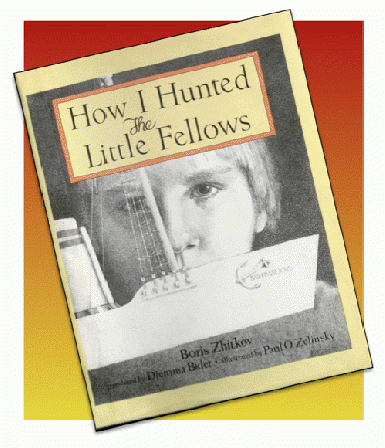PZ: Well, I don't really know, but I doubt whether most adults in this country take children's book writing as seriously as I do! Before I got my first children's book to illustrate, I did a lot of editorial illustration for newspapers and magazines. But when the opportunity to do children's books presented itself, I pretty quickly stopped that other kind of work. Maybe I wasn't as good at it, but I was intensely aware of how much more my drawings in a children's book would mean to its readers than did, for instance, my drawings for Barron's Weekly, a financial newspaper. There used to be a saying about the long-term value of what's in a newspaper, something like "today's newspaper wraps tomorrow's fish."
JB: At what point did what you did go from simply amusing yourself and your friends to something bigger?
PZ: Well, in one sense, amusing myself and my friends (mostly myself) is still what I'm trying to do, though I suppose that if my published books amused nobody else, I'd be in a certain amount of trouble. But to answer your question, the possibility of becoming an actual children's book illustrator dawned on me in college, when I was casting around for courses to take or activities to sign up for that might provide some career path to a college graduate with an art major. I'd been lucky enough to get into Yale College, and when as a Sophomore I saw in the always-fascinating course catalog a seminar (a special offering, not part of any department) on the subject of children's literature, and noted that the teacher would be Maurice Sendak (along with an English faculty member), it looked like quite an opportunity.
The course was both academic and creative; all of the accepted students wanted to write or to write and draw, and by the end of a very inspiring term, led by a fascinating and committed teacher, it seemed the most natural thing to do to send off our efforts to publishers. (I wrote an essay about this seminar a couple of years ago in the book Maurice Sendak: a Celebration of the Artist). Later that year, my collaboration with another student in the class was accepted for publication by a small but distinguished house that had published Margaret Wise Brown, Clement Hurd, Gertrude Stein, Leonard Weisgard and others!
Unfortunately for everyone, before there was a contract, that publisher was bought by a large educational corporation, and dissolved. So I wasn't yet published, but the seed had been planted. Still, I followed the default path laid out for college art majors: to get a master's degree in painting, and teach college art. And at the end of that process, as a beginning college art teacher, I had the sense that this was not what I was meant to do. I also had the awful feeling that my students were reacting similarly. So I moved to New York to try my hand at book illustration.
JB: How did the move affect your career trajectory?
PZ: It only turned a none-too-promising career in art education into a turns-out-to-have-been-pretty-successful career in children's book illustrating! I think it was a good move.
That was in the late 1970s, before the advent of most of the instant communication that's so easy to take for granted today. If you lived far from the publishers, who were almost all in New York, being a working book illustrator would not be easy. I think it's quite possible that if I hadn't been showing up at publishers' offices with my portfolio, I might not have been the illustrator they thought of to pair with the manuscripts that were in fact offered to me. You can't ever really know something like that, of course.

Cover art for the first published picture book Paul illustrated
(Image by courtesy of Paul O. Zelinsky) Details DMCA
JB: True. You've juggled illustrating books written by others with creating your own. How does that work? Did your illustrating open doors for you as a new children's author?
PZ: I suppose that after a couple of books, when I had established connections with an editor and could propose a book idea of my own, in person and in passing, it probably got more consideration than the same idea would have if it had arrived from a stranger in the mail. But I'm pretty idealistic about how book submissions work; that is, I think good ideas get recognized.
JB: Your classic, The Wheels on the Bus, celebrated an amazing 25 years in print back in 2015. How did you come up with the idea for a pop-up book? Was this your first attempt at it? Please share the backstory with us.
PZ: I tell this story, and it's always the same, but what can I do? It's true. I think I'm the only American I know who didn't learn the song "The Wheels on the Bus" in childhood. I learned it from my wife. Deborah was working on her doctoral thesis in Music Education, conducting a study on teaching spatial concepts, testing whether words like up and down and in and out, which aren't understood by the smallest children, are learned better and faster with the help of music. (They are.) So she was teaching some of her kindergarten classes--she was the music teacher in a Brooklyn public school--songs where those concepts come through, one of which was "The Wheels on the Bus."
I saw the sheet music on her desk. I read it. It sounded catchy. I thought that if children learn spatial concepts from the actions in this song, wouldn't it be an even stronger experience if there were a book where those actions took place in a real, physical way? Where while you sing "round and round" you can spin actual wheels with your fingers, seeing and feeling them go round and round? Or pop doors open and shut, or slide windows up and down? It would be kinesthetic, rhythmic, visual, aural, vocal, all at once.
This idea seemed pretty good, and I brought it to my editor at Dutton, Donna Brooks. From my bit of checking, it looked like the text of this song had never been made into a children's book, much less a moving-parts book. But neither of us knew how to go about making a book with wheels that spin and doors that open, so I put the idea off to the future. A couple of times over the next few years I noticed the title "The Wheels on the Bus" in children's book publishers' new book catalogues, and got nervous.
Next Page 1 | 2 | 3 | 4 | 5 | 6
(Note: You can view every article as one long page if you sign up as an Advocate Member, or higher).






